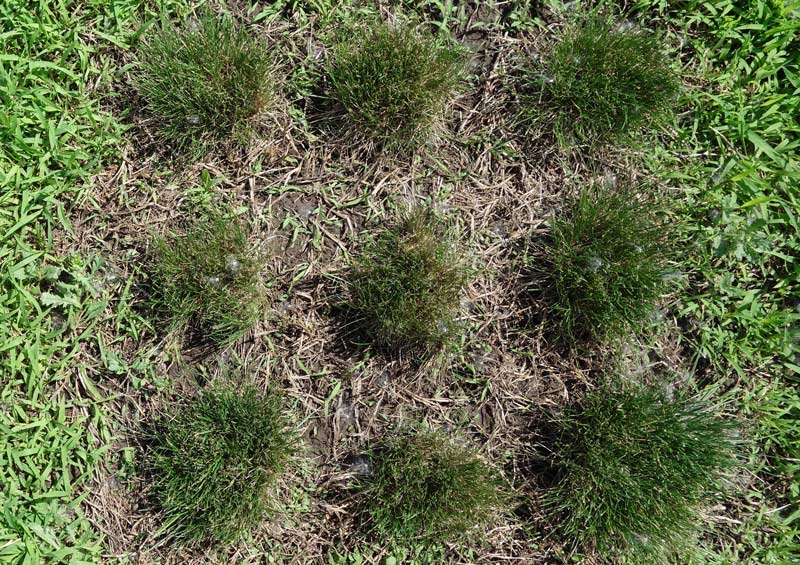
Some fine fescues appear to be able to inhibit crabgrass germination, as seen in this field experiment. Photo by Jon Trappe
Plants interact with each other above ground (competing for light) and below ground (competing for water and nutrients). A specific case of a negative plant-plant interaction is called “allelopathy,” which occurs when a plant produces and releases into the environment herbicidal compounds that harm neighboring plants through various modes of action.
A good example is the case of the bottlebrush plant (Myrtaceae species), which is known for releasing a herbicidal compound called leptospermone, an allelochemical that “bleaches” nearby susceptible plants. Research on leptospermone led to the creation of mesotrione, the active ingredient in products such as Tenacity and other commercial “bleaching” herbicides. Studying allelopathy can be helpful for designing new herbicides, but it also has broader implications in plant breeding.
Fine fescues have been suspected of having natural weed-suppressive abilities. Previous work from Cornell University identified a chemical compound, L-m-tyrosine, as a potential allelochemical responsible for the weed suppression observed in field experiments. This concept is particularly interesting from a breeding perspective, because natural weed suppression offers the potential of breeding for turfgrasses that require fewer pesticide applications.
The University of Minnesota Turfgrass Science team has been actively involved with breeding and evaluating fine fescues, largely because fine fescues have lower maintenance requirements than other cool-season turfgrasses adapted to the region. We began evaluating fine fescues for natural weed suppression in 2014, which has steered our current efforts toward screening for crabgrass suppression. Crabgrass (Digitaria species) is a problematic summer annual grassy weed across much of the United States, making it a good candidate for screening fine fescues for weed suppression.
Fine fescues were screened for weed suppression in plots with consistent crabgrass populations in fields at the University of Minnesota Turfgrass Research and Outreach Center in St. Paul, Minn., and at the William H. Daniel Turfgrass Research and Diagnostic Center in West Lafayette, Ind.
In our initial field experiment, we tested six accessions and one cultivar for three fine fescue species: hard fescue (Festuca brevipila), Chewings fescue (Festuca rubra subspecies fallax), and strong creeping red fescue (Festuca rubra subspecies rubra). We planted the fine fescues as plugs in the field in Minnesota and Indiana in April 2016 in order to evaluate the effect of fine fescues on natural crabgrass populations.
After two years of study in field conditions, we observed several trends in crabgrass suppression. There were significant differences in overall crabgrass biomass reduction and the amount of seedheads produced, with consistent trends across the Minnesota and Indiana crabgrass populations. In spring 2018, we also observed differences in crabgrass emergence in the Minnesota field location.
To verify the observations made in the field experiment and to better understand how resource competition can affect weed suppression, we conducted a separate experiment in a controlled-environment growth chamber to test fine fescues from the field that had shown both high and low levels of crabgrass suppression. Similar trends in the reduction of crabgrass biomass, seedhead production, and tiller and leaf number in the controlled environment verified our previous field observations.
We also conducted further research under lab conditions to confirm that the suspected allelochemical L-m-tyrosine negatively affected crabgrass, potentially explaining field and growth chamber observations.
We found that crabgrass suppression varies within and across fine fescue species. Chewings fescues and strong creeping red fescues tended to suppress crabgrass more than hard fescues. These methods and their future results will be helpful in identifying genotypes with higher suppressive/allelopathic ability, which will be used to breed fine fescues that require fewer pesticides.
In our future research, we will attempt to determine whether a single allelochemical is responsible for crabgrass suppression, screening for weed suppressive genotypes against other problematic weed species and seeking a better understanding of the effect of resource (especially nitrogen and phosphate) competition for weed suppression by fine fescues.
A more detailed report of this research will be submitted for publication in a peer-reviewed journal in spring 2019. This research was funded by the USDA and the National Institute of Food and Agriculture through the Specialty Crop Research Initiative.
Jon M. Trappe and Dominic Petrella are postdoctoral associates, Florence Sessoms is a research scientist, and Eric Watkins is a professor of turfgrass breeding and genetics at the University of Minnesota Twin Cities in St. Paul, Minn.